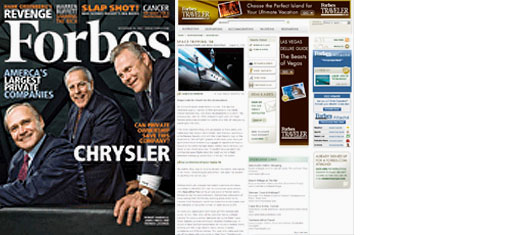
>download
Magazine
Forbes “Traveler”
GALACTIC SUITE
(USA)
SPACE TRIPPING: OUT-OF-THIS-WORLD ADVENTURES
[…] At $4 million (give or take), a vacation at Galactic Suites is a comparative bargain. Projected to open in 2012, the planet’s first space resort promises to orbit 15 times a day at 18,000 mph. The trip requires an 18-week commitment, most of which is spent at a 007-style space camp on an undisclosed Caribbean Island. “Galactic Suite is really tapping into the fantasy aspect,” says Michael Yessis, co-editor of World Hum, a Travel Channel web site. “Who wouldn’t want to be launched into orbit Bond-style, saying something pithy in a tux or evening gown?”
The figurative tux or gown is in fact a Velcro-covered getup designed for easy maneuvering around this hotel and, yes, space spa. […]
As the average Trekkie counts down to next year’s big-screen prequel, hardcore space fanatics are waiting patiently for the year 2010, when Virgin Galactic hopes to start sending the VSS Enterprise, and six paying customers at a time, into the cosmos.
For $200,000 apiece, civilian astronauts will receive: three days of training, a ride aboard a mother ship to 50,000 feet and subsequent 2,500 mph hurtle through the edges of the atmosphere, five minutes of weightlessness and earth-ogling, and a g-force-intensive, supine landing. (If nothing else, it’ll be a novel alternative to the “full and upright position.”) Total flight time? About two and a half hours.
Specific launch dates are not yet set. “We’re about three quarters of the way through the construction of the spaceship system, and plan to unveil it in the first half of 2009,” says Virgin Galactic president Will Whitehorn. The second half of 2009 will be dedicated to test flights; if all goes well, commercial flights will begin the following year.
No doubt, the vague timetable frustrates would-be astronauts who want to start their countdown clocks as soon as possible. But safety cannot play co-pilot to deadlines. According to Patti Grace Smith, the Federal Aviation Authority’s associate administrator for Commercial Space Transportation, a passenger launch will happen only after “years of analysis, development, testing, redesign, adjustment and additional testing.”
And even so, “this is an ultra-hazardous business.”
Hence the Commercial Space Launch Amendments Act of 2004. “The government’s principal role,” says Smith, “is developing a regulatory regime focused on the safety of the uninvolved public.” In other words, the average, earthbound Joe who doesn’t have much experience with debris showers. At the same time, the FAA doesn’t want to “stifle the emerging private human space flight industry.”
Despite granting space entrepreneurs ample latitude in the interest of rapid innovation, “Congress didn’t pull any punches in pointing out to potential space travelers that if they wanted to do this, fine,” says Smith. “But they needed to do it with their eyes wide open.”
So, first-generation astro-tourists will be deemed “flight participants” instead of “passengers.” By this distinction, they’ll be likened to adventurers who knowingly and willingly engage in substantial risk. Accordingly, they must agree not to sue the federal government for anything that goes wrong.
“Ours is a well-managed risk,” says Space Adventures CEO Eric Anderson, best known for delivering private citizens to the International Space Station for $30 million a pop. “The Russian Soyuz spacecraft hasn’t had a fatality in the past 30 years—it’s much more dangerous to climb Mt. Everest.”
So far, Anderson has sent five people into space. Next up is space travel’s first legacy: Richard Garriott, son of NASA astronaut Owen Garriott, will depart next fall. Anyone willing to wait longer than Garriott (exactly how long is not yet clear) will be able to take a walk outside the space station. Though still in development, a space walk would cost an additional $15 million, and, as Anderson notes, is “something very few professional astronauts have done.”
There’s even talk of circumlunar flights. Anderson hopes to whirl his customers around the moon, where only 24 humans have been. At some point in the next four years, number 25 will pony up $100 million for that particular bragging right. “This is the most expensive travel offering I know of,” he says.
At $4 million (give or take), a vacation at Galactic Suites is a comparative bargain. Projected to open in 2012, the planet’s first space resort promises to orbit 15 times a day at 18,000 mph. The trip requires an 18-week commitment, most of which is spent at a 007-style space camp on an undisclosed Caribbean Island. “Galactic Suite is really tapping into the fantasy aspect,” says Michael Yessis, co-editor of World Hum, a Travel Channel web site. “Who wouldn’t want to be launched into orbit Bond-style, saying something pithy in a tux or evening gown?”
The figurative tux or gown is in fact a Velcro-covered getup designed for easy maneuvering around this hotel and, yes, space spa.
But not everyone thinks space travel should be a luxury endeavor. “It’s time to open the space frontier to citizen explorers,” says Buzz Aldrin, the second man to set foot on the moon. Working through his ShareSpace Foundation, Aldrin hopes to put space travel within anybody’s reach. “We intend to launch the ShareSpace Adventure Awards program to award winners with actual trips into space.”
Whether you take the first-class ticket for $100 million, or you land the ultimate comped trip from ShareSpace, space travel is firmly on the horizon.
